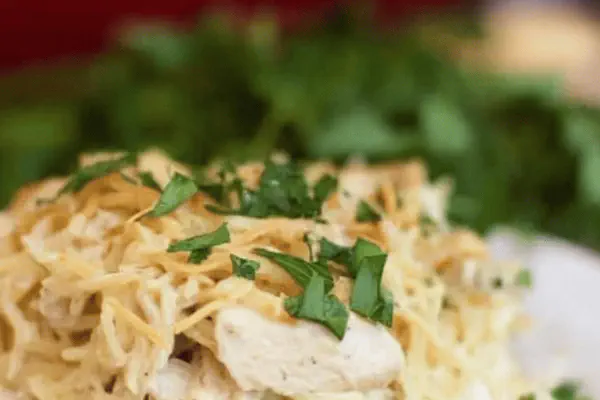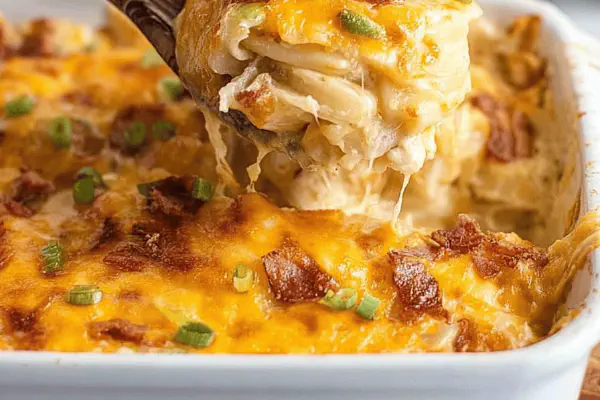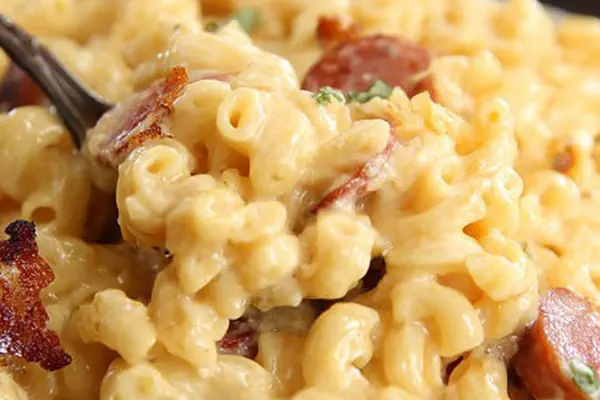Retro Chicken Tetrazzini

By Emma
Certified Culinary Professional
Ingredients
- 6 cups chicken broth or stock
- 8 ounces vermicelli pasta or thin spaghetti broken into 3-4 inch pieces
- 1 can cream of mushroom soup
- 1 can cream of chicken soup
- ½ cup grated Parmesan cheese plus extra for topping
- 1 teaspoon garlic powder
- 1 teaspoon onion powder
- Salt to taste (start with ½ teaspoon)
- 3 cups cooked chicken meat, chopped into bite sized pieces
- Butter for greasing casserole dish
- Optional twist: swap half chicken broth with dry white wine for depth
About the ingredients
Method
- Heat oven to 380°F. Butter inside a 9x13 baking dish thoroughly—prevents crusty sticking; trust me on this.
- In large pot, bring chicken broth to rolling boil. Toss in vermicelli gently, stir once or twice so pasta doesn’t clump.
- Cook for 8-12 minutes; noodles should be tender but not mushy. Taste often. Drain but keep them sitting in residual heat to finish softening—about 5 minutes.
- In a medium bowl, whisk together both cream soups, garlic and onion powders, salt, and half the Parmesan. This mix will be your glue and flavor bomb. Taste it before layering; adjust salt or add a dash of pepper if needed.
- Cut cooked chicken into small uniform bits. If meat looks dry, toss with a spoonful broth or splash of olive oil to keep moist inside casserole.
- Layering now—spread half the pasta on bottom. Press down lightly so you get density but not smashed.
- On top, scatter half the chicken evenly. Then dollop half the creamy soup-cheese blend over that. Pat gently to spread but it’s OK if some spots peek through.
- Repeat the layers exactly the same: pasta, chicken, creamy mixture. Press again to compact slightly.
- Sprinkle remaining Parmesan cheese over the top layer. This helps create a golden, bubbly crust.
- Cover casserole with foil tightly. Bake for 40-50 minutes. The foil traps steam and heats through without drying out chicken or noodles.
- Remove foil and continue baking uncovered for another 10-15 minutes. You want visible bubbling on edges and juicy, steamy center. If bubbling hasn’t started in the middle yet, give it more time—don’t risk undercooked chicken lurking within.
- Let casserole rest 10 minutes before serving. The layers settle, flavors marry, and heat distributes. Cutting too early leads to sloppy slices.
Cooking tips
Chef's notes
- 💡 Butter casserole dish thoroughly before layering; dry pans cause crust to stick and pull when serving. Pasta sticks if skipped. Butter also insulates edges—watch golden color form during uncovered bake phase.
- 💡 Simmer broth then boil pasta 8-12 minutes depending on vermicelli brand; noodles must be tender but still firm. Drain carefully, keep residual heat to soften, no rinsing or stirring aggressively. Key to avoid mushy strands.
- 💡 Mix soups and powders with half Parmesan first. Taste before layering. Adjust salt cautiously because soups vary in saltiness. Garlic and onion powders smell muted compared to fresh but avoid bitter burnt bits that raw garlic causes.
- 💡 Chicken must be pre-cooked and bite-sized for even heating; toss with broth or olive oil if meat feels dry before layering. This prevents dry patches once baked, moisture disperses slowly inside thick casserole layers.
- 💡 Cover tightly with foil first bake to trap steam. Prevents drying out noodles and chicken inside casserole. Uncover last 10-15 minutes for bubbling edges and golden cheese crust. Visual cues beat watch-and-guess timers every time.
Common questions
Can I use fresh garlic instead of powder?
Fresh garlic tends to brown and bitter when baked long. Powders give consistent aroma without harsh burnt notes. If fresh used, sauté lightly first. Alternative powders keep flavor even.
How do I fix soggy noodles?
Overcooked pasta swells and breaks down. Cook noodles shorter than normal, let residual heat finish softening off-heat. Avoid rinsing; starch helps hold sauce. If soggy, bake uncovered longer to dry top layers.
Safe to use raw chicken?
No. Raw chicken risks uneven cooking inside thick bake. Pre-cooked or rotisserie chicken ensures safe internal temps with no guesswork. For raw, you'd have to par-cook pasta less and bake longer watched closely.
How to store leftovers?
Cool quickly to avoid bacteria. Cover and refrigerate 3-4 days. Reheat covered at lower temp to keep moisture. Freeze in airtight containers up to 3 months; thaw first to avoid drying edges when baking crisp again.



